» posted on Tuesday, June 25th, 2013 by Linda Lou Burton
Windmills Of My Mind
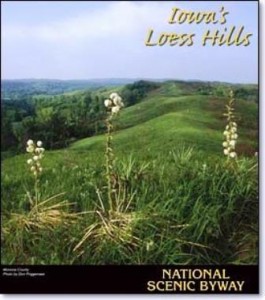 Linda Burton posting from Des Moines, Iowa – A thunderclap knocked me out of bed; a 9 on a scale of 10. Lincoln had stormed me in; Lincoln was storming me out. But it rapidly moved east; by the time I dressed it was starting to clear. The cats were the fourth load; the sun came out and the humidity came up; I turned the cooler on and set the GPS for Des Moines. A mile to the freeway; I-80 East was all I had to remember today. Cross the Platte River, edge around Omaha, cross the Missouri River, and the Journey entered its 35th state. The minute I crossed the line the landscape changed. I entered the Loess Hills of western Iowa, a unique land formation adjacent to the Missouri River Valley. Though deposits of “loess” are found around the world, nowhere else but in
Linda Burton posting from Des Moines, Iowa – A thunderclap knocked me out of bed; a 9 on a scale of 10. Lincoln had stormed me in; Lincoln was storming me out. But it rapidly moved east; by the time I dressed it was starting to clear. The cats were the fourth load; the sun came out and the humidity came up; I turned the cooler on and set the GPS for Des Moines. A mile to the freeway; I-80 East was all I had to remember today. Cross the Platte River, edge around Omaha, cross the Missouri River, and the Journey entered its 35th state. The minute I crossed the line the landscape changed. I entered the Loess Hills of western Iowa, a unique land formation adjacent to the Missouri River Valley. Though deposits of “loess” are found around the world, nowhere else but in 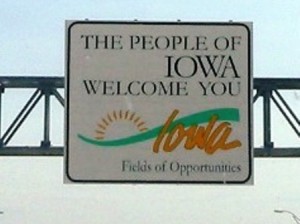 China are areas of windblown silt higher than in Iowa. The Loess Hills encompasses over 640,000 acres of land; 10,000 acres are designated “Loess Hills National Natural Landmark.” People flock to visit the outstanding prairie-and-forest-covered bluffs and the archaeologically rich hills; in 2008 the State Archaeologist recorded over 1,500 inventoried sites. I stopped at the Iowa Welcome Center about 20 miles in; a marker there told of historic Council Bluffs, so named for an 1804 meeting of the Lewis and Clark Expedition with the Otoe Tribe. The Missouri and the Platte,
China are areas of windblown silt higher than in Iowa. The Loess Hills encompasses over 640,000 acres of land; 10,000 acres are designated “Loess Hills National Natural Landmark.” People flock to visit the outstanding prairie-and-forest-covered bluffs and the archaeologically rich hills; in 2008 the State Archaeologist recorded over 1,500 inventoried sites. I stopped at the Iowa Welcome Center about 20 miles in; a marker there told of historic Council Bluffs, so named for an 1804 meeting of the Lewis and Clark Expedition with the Otoe Tribe. The Missouri and the Platte, 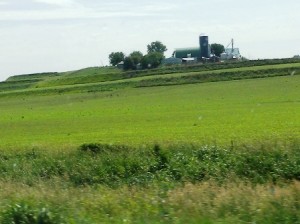 so significant to explorers and settlers in the westward movement. Back on the road, bright green slopes began to fill my view, different from the farms I’d seen in Kansas and Nebraska. They were terraced farms; gentle contours edged with grasses in between the crops. And then, a truck whizzed by, hauling a giant blade. A blade for a wind turbine? Wind farms in Iowa?
so significant to explorers and settlers in the westward movement. Back on the road, bright green slopes began to fill my view, different from the farms I’d seen in Kansas and Nebraska. They were terraced farms; gentle contours edged with grasses in between the crops. And then, a truck whizzed by, hauling a giant blade. A blade for a wind turbine? Wind farms in Iowa?
 Sure enough, wind turbines began popping up like daisies, right and left; dotting the green-terraced hills; more blade-hauling trucks passed me by; I counted fifteen in a fairly short stretch. I knew Iowa produced more hogs and corn than any other state; I was surprised to learn that it is a leading state in wind power generation too. As of 2012, about a fourth of the state’s electricity generation comes from wind power; the state has 5,137 megawatts (MW) of capacity, third only to Texas and California. Wind farms are most prevalent in the north and west portion of Iowa; some of the projects are the large 440 MW Rolling Hills project near Massena, the Pocahontas Prairie
Sure enough, wind turbines began popping up like daisies, right and left; dotting the green-terraced hills; more blade-hauling trucks passed me by; I counted fifteen in a fairly short stretch. I knew Iowa produced more hogs and corn than any other state; I was surprised to learn that it is a leading state in wind power generation too. As of 2012, about a fourth of the state’s electricity generation comes from wind power; the state has 5,137 megawatts (MW) of capacity, third only to Texas and California. Wind farms are most prevalent in the north and west portion of Iowa; some of the projects are the large 440 MW Rolling Hills project near Massena, the Pocahontas Prairie 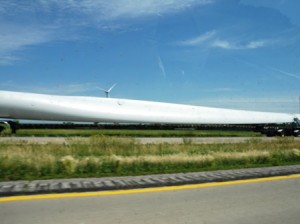 project northeast of Pomeroy, and the Elk Wind Farm near Greeley; all constructed in 2011. Further growth of wind farms is somewhat restricted due to lack of transmission line capacity; this is actually a major hurdle to increased development in the US.
project northeast of Pomeroy, and the Elk Wind Farm near Greeley; all constructed in 2011. Further growth of wind farms is somewhat restricted due to lack of transmission line capacity; this is actually a major hurdle to increased development in the US.
I also learned that those big blades passing me by on the freeway are manufactured in Iowa, by TPI Composites in Newton and by Siemens in Fort Madison. Clipper Windpower in Cedar Rapids and Acciona in West Branch manufacture the turbines; Trinity Structural Towers in Newton manufactures the towers. Various companies support the 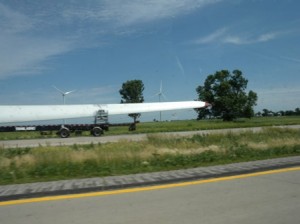 development of the projects themselves; wind farms are generating jobs as well as electricity; the industry employs more than 3,000 people now. A blade spinning on a tower looks huge, but the scope is too large to comprehend; seeing a blade on a truck bed makes you blink; they are simply too wide for the camera lens. The blades manufactured at Siemens factory in Fort Madison are 148 feet long, and weigh 12 tons; these blades are used with 2.3 MW wind turbines. The 2.5 MW Liberty wind turbines manufactured by Clipper in Cedar Rapids are being used in the Endeavor project in northwest Iowa, and in the Titan Wind Project in South Dakota. I pulled off at a
development of the projects themselves; wind farms are generating jobs as well as electricity; the industry employs more than 3,000 people now. A blade spinning on a tower looks huge, but the scope is too large to comprehend; seeing a blade on a truck bed makes you blink; they are simply too wide for the camera lens. The blades manufactured at Siemens factory in Fort Madison are 148 feet long, and weigh 12 tons; these blades are used with 2.3 MW wind turbines. The 2.5 MW Liberty wind turbines manufactured by Clipper in Cedar Rapids are being used in the Endeavor project in northwest Iowa, and in the Titan Wind Project in South Dakota. I pulled off at a 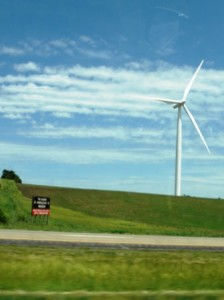 rest stop to try and get a closer shot of an operating wind turbine tower; the perspective never worked; meanwhile; more blades went rolling by on the freeway; headed for installation, somewhere.
rest stop to try and get a closer shot of an operating wind turbine tower; the perspective never worked; meanwhile; more blades went rolling by on the freeway; headed for installation, somewhere.
A freeway sign advised me to take Exit 54 to Elk Horn, and the Danish Windmill Museum. I was tempted, but decided to stick to schedule. Still, the question came to mind: what is the difference between a windmill and a wind turbine? And do we call these large electricity-producing devices “wind turbines” even though the turbine itself is the device that converts wind energy into mechanical energy? Technically, I learned, the entire composition – tower, blades, and turbine – makes up a wind power plant; our choice of vocabulary seems to be moving towards simply “wind turbine” for that; the old-fashioned “windmill” such as the one on display in Elk Horn at the Danish Museum is used to drive machinery, such as grinding grain or pumping water. There, I’ve got that straight, sort of.
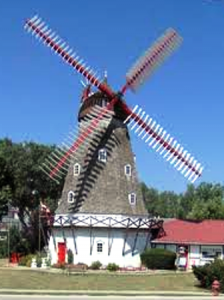 I wish I’d had time for Elk Horn, it has America’s only authentic working Danish Windmill and it is historic; it was originally built in
I wish I’d had time for Elk Horn, it has America’s only authentic working Danish Windmill and it is historic; it was originally built in  Denmark in 1848! It was brought to Elk Horn and assembled in 1976 by community volunteers; when you visit the mill, you can also visit the “VikingHjem;” it depicts the life of a Viking smithy in 900 AD. Another freeway sign advises of “John Wayne’s Birthplace” to the south; when I entered Madison County, a memory triggered in my mind. “The Bridges of ?” The movie, and the book? They were close enough to come back.
Denmark in 1848! It was brought to Elk Horn and assembled in 1976 by community volunteers; when you visit the mill, you can also visit the “VikingHjem;” it depicts the life of a Viking smithy in 900 AD. Another freeway sign advises of “John Wayne’s Birthplace” to the south; when I entered Madison County, a memory triggered in my mind. “The Bridges of ?” The movie, and the book? They were close enough to come back.
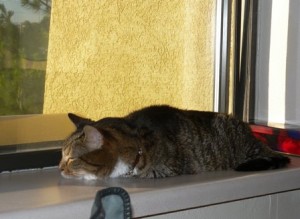 And then I reached Des Moines, population 203,433 (US Census 2010), the 19th-largest capital city. “We’re 70% done now,” I advised the cats. 70%! The Journey once was just an idea turning in my mind, now it was 70% complete. Hotel checkin went smoothly; the unload too. A fourth-floor room and quiet; yellow daylilies blooming everywhere reminded me of my own front yard; a little bit of homesick hit. Alex Cat jumped on the wide window-ledge and settled in; outside the prairie grasses swayed. The wind was blowing in Iowa. But not too hard.
And then I reached Des Moines, population 203,433 (US Census 2010), the 19th-largest capital city. “We’re 70% done now,” I advised the cats. 70%! The Journey once was just an idea turning in my mind, now it was 70% complete. Hotel checkin went smoothly; the unload too. A fourth-floor room and quiet; yellow daylilies blooming everywhere reminded me of my own front yard; a little bit of homesick hit. Alex Cat jumped on the wide window-ledge and settled in; outside the prairie grasses swayed. The wind was blowing in Iowa. But not too hard.
Loess Hills of Iowa http://www.inhf.org/loess-hills.cfm
Danish Windmill Museum http://www.dkmuseum.org/
